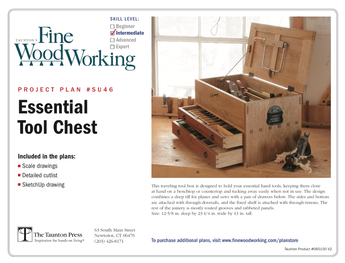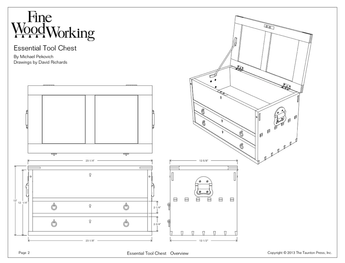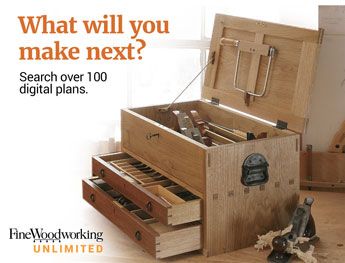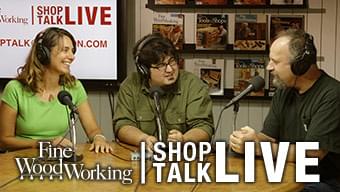This is my first post. My name is Justin and I am a finish carpenter in Chicago.
I recently purchased a Lie Nielson Edge Trimming Block Plane (#95) to be used for cleaning up the mill marks that my job site table saw occasionally leaves and for dressing the often poorly milled edges that come on stock delivered from local suppliers. I have been playing with the tool for about a week and have had trouble getting consistent results. At times the tools seems to want to plane a slight bevel in the material even though I have the iron adjusted square to the throat and have triple checked the squareness of my table saw. I also checked the fence on the plane for square. All of this was done with an Incra try square.
In my garage I clamped my work piece on edge in a pair of bench vises on my work table and on the job site I have clamped the material flat the the outfeed table of my table saw. The results are more often than not the same. The shavings come out in progressively increasing widths and occassionaly the edge gets beveled.
I am sure that the problem is not with the tool. It seems to have the same quality that I have come to rely upon from my other Lie Nielson tools (#102 block plane, Butt Mortise plane, and spoke shave). With the table saw ruled out I can only guess that the problem lies either in my technique or in the consistency of the milling of the material that I have been using it with.
Any insights or suggestions will be sincerely appreciated.














Replies
Hi Justin
I have this version of the #95 as well - can't say that I have noticed the effect you are reporting.
If everything is checked square - and I assume that you have done a few trial cuts and checked the squareness oif the result - and the problem is occasional, that is it does not occur consistently - then the problem may lie with the wood. Is there something in common in the examples you have, such as the low angle blade following the grain? Are you taking a fine- or a deep cut each time?
Regards from Perth
Derek
I am taking fairly light cuts. The shavings are tranlucent. The stock is poplar 1x which the GC swears is s4s even after I pointed out the planing marks left by a thickness planer and the smooth and obviously drum sanded opposite side. The stock varies in thickness b/w 3/4 and 13/16. You don't always get a choice as to the material you will be using.
I'm thinking the plane may be following twists,cups, and humps in the wood. As I said the shavings progressively get wider which is the plane squaring inconsistencies. If the surface the fence follows in poor that may result in the finish that I'm finding.
I don't think the iron is following the grain, but I could be wrong.
BTW would the iron on this type of plane benefit from hollow grinding?
Hi Justin,
A couple thought. First, if the plane starts out proper and then you get variable results, it may be from technique--not keeping the fence truly to the reference face--or possibly from the blade shifting during the cut. On a skewed bed such as the 95 this will produce such an effect.
Also, this plane is really only adept at a few swipes. I don't believe they are meant for repeated stock removal. In practice, it is easy to allow the hand to waver and so produce the beginnings of a beveled edge. Each subsequent pass may well magnify this error.
Another possibility. I have, in the hurry of the moment, clamped my board high enough out of the vise that with excessive sidways pressure the board has bowed along the length. This will produce a wonky edge.
To check your technique, take a board and rip it with your tablesaw. Check the edge, both down its length for an even straight line cut, as well as for an edge which is a 90 degree. Take a pass with the 95. Is it still square? Take another pass. Still square? If not, it is probably a combination of technique and the inability of such a short plane to continue producing a square edge.
Take care, Mike
I have the same problem with my stanley 95, and experienced the same problem with a 386 fence on a #7.
My fix of the the #7 and 386 fence was to tack a board on the fence so that all the pressure was on the centre of the plane blade. Of course when it is all on one side, it is only natural that the blade may well move back, due to the experience of pressure on only one side.
Try attaching a wooden scrap to the fence of yer 95oid so that the pressure expereinced by the blade is in the cente, not on one side, That may help.
Also, visit yer local discount distributor and buy an imported machinists square for next to nothing. Do check it of course, for squareness, but oftentimes even the cheapest machinists square is made to more exacting standards than any woodworkers square, although I've had one that was "off"
Incidently, my Stanley 95 is NOT square.
Hope that helps.
Eric in Calgary
Yes, do check it and if it isn't square, call LN and send it back or file it square, or add a corrective wood auxillary fence as suggested. Me? I would file it and be done. But then, I'm fearless to a fault when it comes to modifying/correcting tools, even new ones.
fwiw, both my LN left and right versions were square.
Take care, Mike
Did you check your S4S stock with a straight edge for cupping? I find that, since the plane fence that registers to the reference face of the board is relatively shallow (about an inch?), even a slight cupping will throw off the edge jointing action on a perfectly set up #95. I usually just adjust the blade to compensate, provided the cupping's pretty consistent along the board's length. Good luck.
I have this plane as well, but haven't noticed the problem. One possibility that isn't addressed in the other comments:
If the grain's nearly straight, but veers away from the edge, the cut may be going along the grain line rather than along the sawn face.
Justinm,
I've been chasing this issue also for the past year or so without any real conclusions...but it happens with all my planes...with a single piece of stock..clamped in the bench vise. Perhaps my DNA has me listing to the left when I plane (sigh!).
Two things I'm trying that might help: 1. shim the bench vise at the base. Mine has a slight slope that caused the stock to be grabbed first at the top and, therefore, I speculate, may be causing the stock to shift to the left. 2. I was watching the David Charlesworth video and the way he set up the blade really made a difference...not just feather cuts but cuts from dead center of the plane. He takes a thin small piece of stock and (1/16" thick) and gently rubs it on the bottom of the plane till he gets the blade adjusted to the exact postion, dead center in my case. Applying this approach, along with creating a slight curvature in the plane blade, and you (we)should be able to take shavings that come close but don't necessarily touch the edges.
You mention that the iron is square to the throat. What's really critical is that the edge is parallel to the sole. Sight down it to check. The blade could be mounted slightly off or have a chip under it.
I've never tried a #95, but I have pretty good luck cleaning up edges with either a #7 or a low angle block plane. You shouldn't need to take off a lot of material to get a clean edge.
Pete
Edited 7/22/2006 3:07 pm ET by PeteBradley
Gentleman,
Thank you all for your responses. I worked on the problem in some spare time today and I noticed a few flaws in my technique. When I sat back and analyzed some of my cuts I realized that I had been slightly rocking the plane at times. This combined with the cups and twists in the stock I have been using seem to be the most likely culprits of my problem.
Thank you again for lending your time and expertise to my problem.
Glad it worked out- a word to the wise- whenever I've had an issue (any issue) with a LN tool, I've called LN. They generally find someone to call me back or email me (once Tom himself) and set me to right.LN has made a success of analyzing previous good designs (like the 95) and refining and improving them. To do that I suspect they have had to overcome many of the types of problems that you have sorted through. I think I remember G Hack commenting on his frutration using a #95...hence LN attempts to refine it.One of the pleasures of buying a premium tool like a LN is that you get goo customer support (this is not your father's Home Depot...) so might as welltake advantage of it.
Glaucon
If you don't think too good, then don't think too much...
This forum post is now archived. Commenting has been disabled